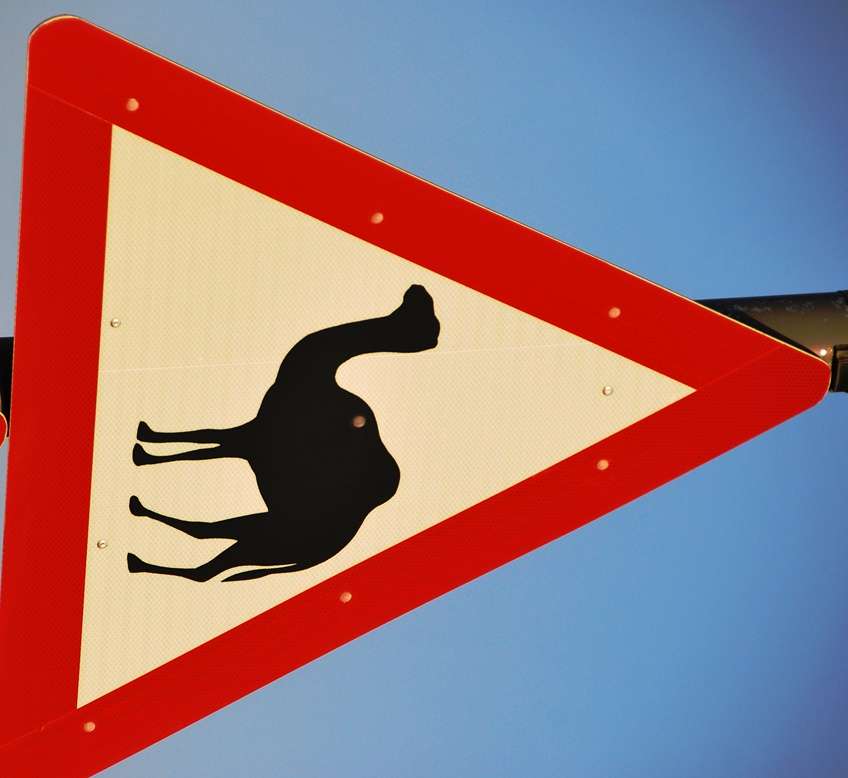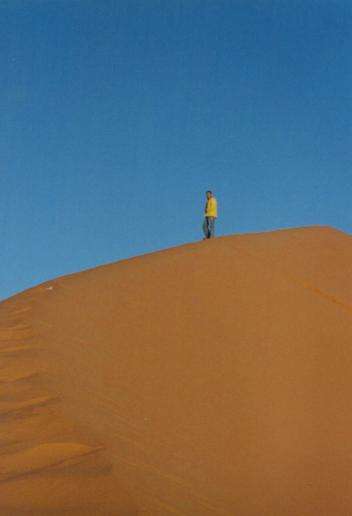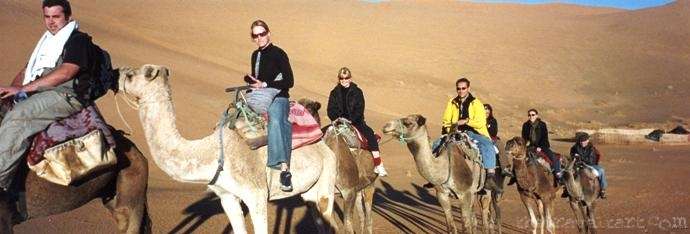Ever wanted to know what it feels like to ride on an animal whose flatulence is transmitted from your backside to your head?
Probably not, but wonder no more! Here is another offbeat camel experience! It’s not exactly what you’d expect from a camel ride in Morocco, and an overnight stay in a tent in the desert!
What it’s like to ride a farting camel in the Sahara Desert!
My barely roadworthy minibus had successfully negotiated through the Moroccan movie town of Ourzazate, passing through the Drâa Valley and Zagora.
One of the interesting road signs that I added to my anecdotal collection of strange sign sightings included ‘Tombouctou 52 jours’. This meant that Timbuktu, in Mali, was only 52 hours away – by a bumpy and smelly camel ride, not by a rust bucket car!
Eventually, we reached the edge of the Sahara and could sight the orange-red sand dunes in the distance, but our driver had lost his bearings and subsequently where our base camp was. He looked for any sign of human life in the desert by scouring the sandy landscape with his black binoculars, and by hurriedly dialling a few numbers on his mobile phone.
After a successful phone contact, I assumed he was saying, ‘Where the hell are you?’ in Arabic and he became more settled, seemingly satisfied as being one of the few men in the world who have ever asked for directions. Maybe we were not that isolated in this supposedly isolated part of the world.

Our driver eventually did find base camp, from where our group were hurriedly assigned six camels for a trek into the Sahara Desert for an overnight camp and sleep pver.
The desert trek was as comfortable as could be expected with a camel’s backbone wedged up one’s butt crack moving up and down, from side to side for a couple of hours.This existence was also accompanied by the added bonus of two painfully compressed testicles from bouncing up and down, and swaying from side to side.
Somehow, I didn’t think men were designed to ride camels for a few hours!
But worse for me, adding to the sore balls syndrome, I had also chosen the most flatulent of the camels, and this often added to the vibrations that required my pelvic area to record these intermittent farts on the Richter scale.

That’s right, my bloody camel probably was on a diet of cabbage and baked beans, and kept releasing the gases from its innards on a regular basis towards the clear blue Moroccan sky. Each rumble from it’s backside translated its force directly between my arse cheeks, which then went up my spine and probably ended up in my skull somewhere – and still stays there to this day.
There’s nothing like experiencing an involuntary camel wedgie!
But I did appreciate the enigma of the camel – a surly, foul-smelling-at-both-ends beast that is also indispensable to many North Africans as a source of transport as it travels over sizzling dunes and has unmatched endurance in such crappy hot conditions.
However, all good things must come to an end. I had to acknowledge that they were a reliable form of transport, as they eventually transported us to a site that consisted of a large, communal canvas tent that was supported by numerous tree branches that must have been imported from Eucalyptus trees in other parts of Morocco.
Inside, the tent was decorated with an assortment of Berber rugs and our sleeping areas for the night – which consisted of a one-inch mattress and a blanket, minus the pillows or sheets. However, the sand seemed to compensate for the lack of sleeping apparel, as it seemed to magically coat the inside of our sleeping bags, transforming our clothes into a useful abrasive material that we could have used to finish-off immaculate wooden furniture with, or at least, effectively exfoliate our skin.
After hoeing into a fabulous aromatic lamb and vegetable tagine with our bare hands, this guaranteed a good night’s sleep in our sandy sleeping bags.
We awoke the next morning to the sight of people climbing the sand dunes, and decided to climb the highest lung-stressing dune simply because it was there. At the sandy summit, we spotted a nomad tent and family on the other side.The tent must have been perched there for a number of days as this remote settlement seemed semi-permanent, considering the large associated goat herd.

Unfortunately, after our one night in the desert, this meant we had to ride our camels back to base. Luckily, the camel I was assigned seem to be flatulent free, but now I had to witness someone else’s pain!
I have seen people become sick on numerous forms of travel – air sick, car sick, sea sick – but never camel sick.
One person in our group, Andrew, had been struck down by this mysterious illness that was almost non-existent in the western world, and he could not bear to ride one these white-phlegm spitting beasts for one second longer.
Occasionally, his projectile spew would erupt, which would be instantly absorbed by the moisture-hungry red sand. The silhouette of the six camels was completed by the silhouette of a cramped Andrew, clutching his guts in agony.

I thought about the 52 hours to Timbuktu sign we all witnessed previously. I guessed that Andrew would have ruled-out reaching this destination solely by camel, but I was confident that he would have left a spew trail throughout the Sahara that may have been fertile enough to support a thin strip of tropical rainforest in western Africa, a trail well-defined enough for other travellers to follow.
We finally arrived at the base camp for breakfast, which consisted of stale bread and orange marmalade. We drove all day, retracing our dodgy mini van tyre tracks, so that we ended back at Marrakech at 8 pm, where we parted ways with everyone forever.
I pondered on the way back about the camel ride – while this rather uncomfortable trip did not involve the combustion of any fossil fuels, it was not greenhouse friendly based on the amount of backside belchers my camel alone released into the atmosphere.
I suspected that if I ever ventured back into the Sahara in 50 years time, this camels greenhouse gases alone would probably transfer this part of the Sahara into an underwater paradise!
So there you go, you’ve been warned! If you’re going on a camel ride, be prepared for the painful consequences! It’s not all romantic and mystical like the travel brochures say!
‘Tombouctou 52 jours’. This meant that Timbuktu, in Mali, was only 52 hours away
Try 52 days, not 52 hours…
Ha, yes my French is terrible… 🙂